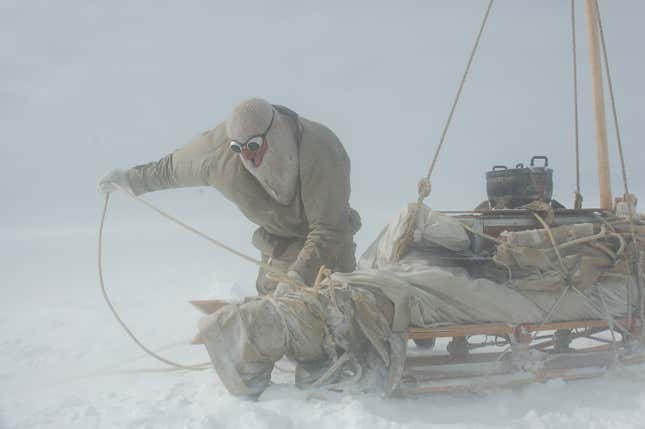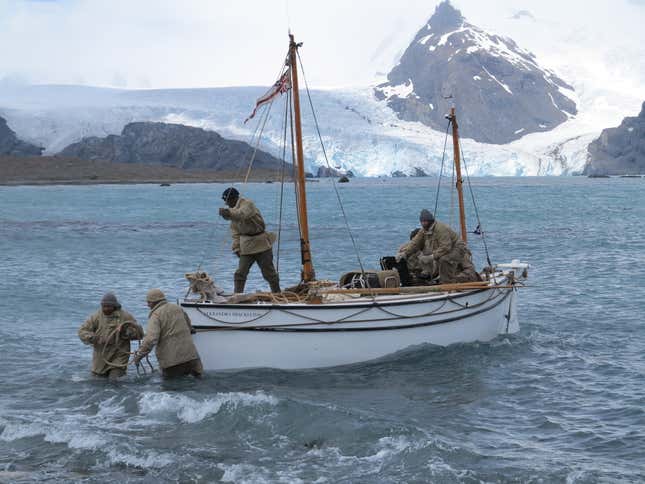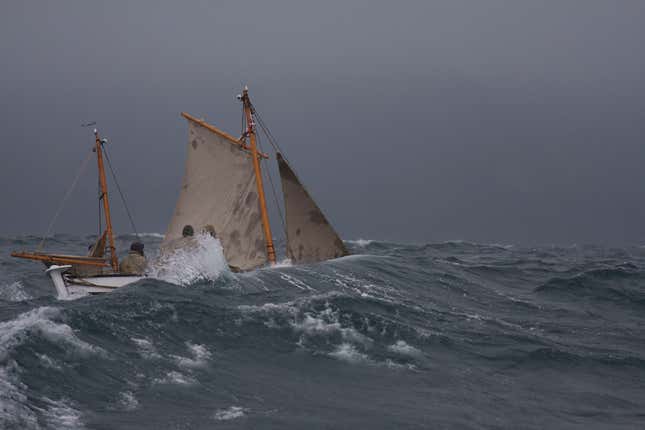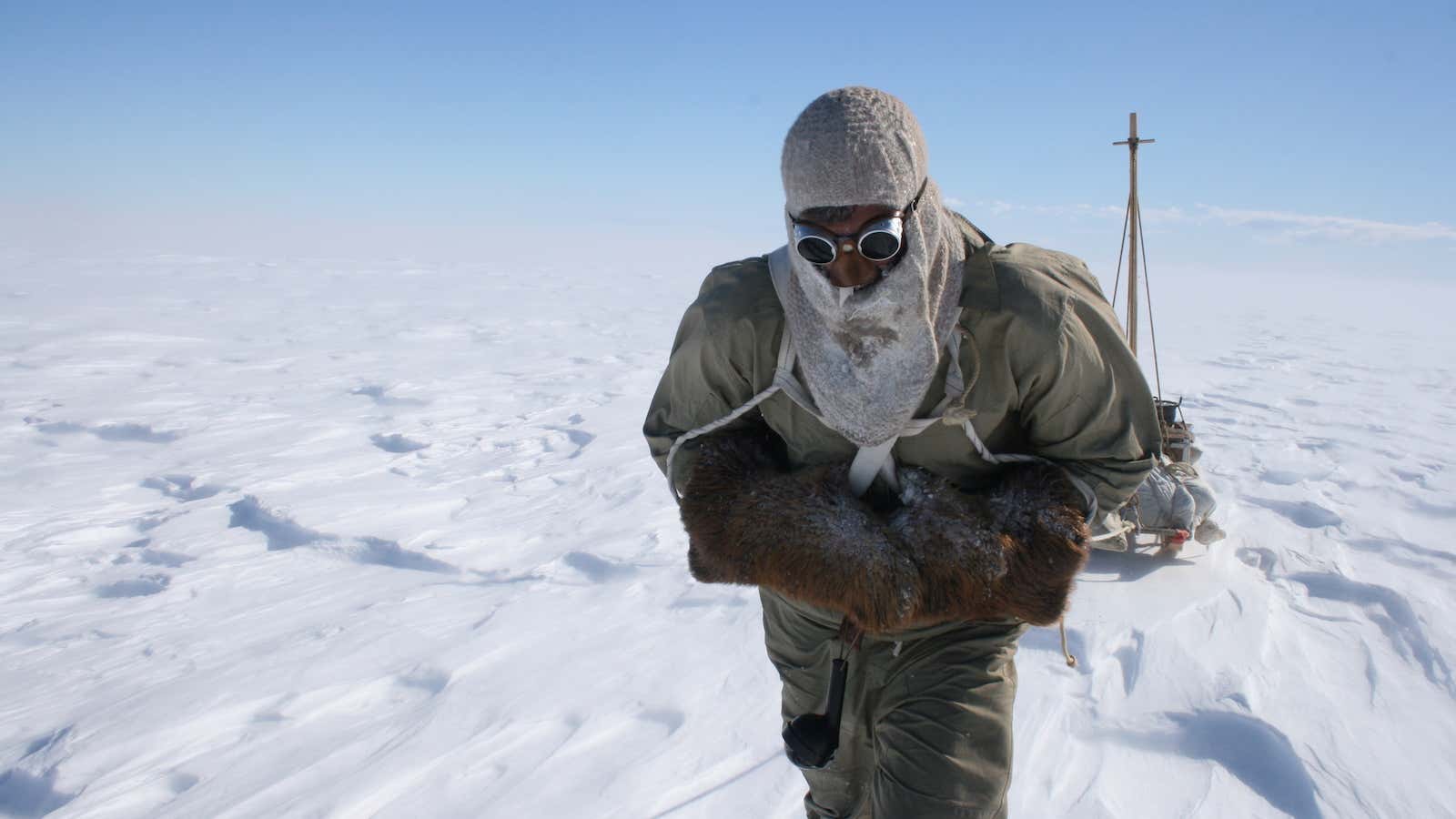Sometimes we have to look to the past to find inspiration for how to impact the future.
One of the best places to look for leadership is in the explorers who have persisted through the most dire of situations—and there are few pioneers with more pluck than Sir Ernest Shackleton. Shackleton’s story of keeping 27 frostbitten men alive for more than 15 months in Antarctica is now taught in many of the world’s leading management schools: Yale, Harvard, Cambridge, Wharton, you name it. NASA even has a Shackleton training program.
Most people use Shackleton’s story to teach teams about leadership. But I think it can teach us how to fight climate change.
It’s one thing to read the accounts of explorers’ death-defying pilgrimages or study them in universities—but it’s quite another to learn from their experiences yourself. I had already relived the journey of one seemingly impossible Antarctic odyssey (shown in the above photo)—that of Douglas Mawson, who was the lone survivor of a 1911 expedition to the South Pole, where he was accused of cannibalizing his fellow explorers. So what was one more?
The Shackleton story
I retraced the 1914 mission of Sir Ernest Shackleton, who went down to the Antarctic with the goal to cross it from one side to the other. He left on the eve of WWI in his ship, the Endurance for a 2,700 km (1,680 mile) journey across the continent.
As you’re probably aware, everything went wrong. The ship got stuck in pack ice, which closed in around its hull. Even though it was a very strong vessel, in the end, the ice crushed the hull, and the only thing holding the ship together was the ice tightly packed in around it. The men were stuck on this vessel for 10 months, surviving off penguin meat and seal blubber. Then for a further five months, they lived a very precarious existence on the sea ice in camps, living under three upturned lifeboats from the main expedition ship.
They were all going to die. Everyone knew it. Shackleton knew it. They knew it. But somehow, his leadership got them through it.
The key takeaway for me is the fact that Shackleton had what we now call emotional intelligence. He knew that teams are made up of individuals, and every individual is different. If you want to have a group of people pull as one to achieve a singular goal—in their case, survival—then you need to tell each person a slightly different version of the story.
The same can be said for climate change. When we approach this issue, we often have a one-size-fits-all fear- and guilt-based messaging system. But we have to be very careful about the messaging we use and get more creative about that messaging to get the issue across; the UN is very different from the US in terms of what influences them, compared to a country like India with 300 million people in rural poverty, or Vanuatu, which is under threat of being submerged in the same way Shackleton’s ship was.

That’s not where the similarities stop. In Shackleton’s case, the ship goes down, they spend 10 months on the ship, five months on the pack ice, then the men get into three lifeboats and paddle for their lives. The nearest piece of land they can find is a jagged rock called Elephant Island. They fall ashore, and they celebrate; as far as they’re concerned, they saved themselves.
But Shackleton knows that they’re all going to die there. Nobody’s going to be able to find them there. The only hope for them is to get the most seaworthy boat and attempt the journey across the Southern Ocean to the nearest habitable place, a little dot in the Southern Ocean some 1,500 km from Elephant Island: South Georgia.
Against all the odds, two storms, one massive hurricane, and navigating using a sextant on a 23-foot-long pitching boat with no keel in the roughest ocean in the world, often in complete darkness, seeing the sun twice to navigate by—they manage to find that little dot in the ocean. If they missed it, the next land was 4,500 km further in Namibia, and obviously they’d be dead.
To further their terrible luck, they arrived on the southern side of the island. The trouble was the whaling stations that were their salvation were on the north side of the island, and in between them was a mountain that had never been climbed. They had no maps, no climbing gear, and no tents. Three of the men had been incapacitated due to the trials and tribulations of the journey, leaving only Shackleton and two others to complete the journey.
So what did they do? They pushed nails through the soles of their boots for grip and did the first crossing of the mountains of South Georgia in a time that modern mountaineers have been unable to replicate even today. They reached the station, raised the alarm, and saved the 22 men they’d left behind on Elephant Island. It was truly remarkable journey.
Replicating Shackleton’s journey
So I decided to give it a go myself.
This is the boat, the Alexandra Shackleton, named after the granddaughter of Sir Ernest Shackleton, who asked me to do replicate her grandfather’s mission. The idea was simple: Suffer as they did, wear old clothing, eat lard, operate a boat with no keel in the roughest ocean in the world, with no GPS, and no emergency supplies of Mars bars. Nothing.

Life in the boat? It’s not for everyone. It’s a cold, unpleasant dangerous journey across the Southern Ocean with no modern equipment, wearing cotton smocks designed for a journey across the windiest continent on the world, not the sea. The ocean is only just about 1°C (34°F), and if you fall in, your survival time is about 10 minutes—not because you go into cardiac arrest, but because after 10 minutes your legs lock up as you tread water, and you drown.
Most the time spent at the helm of the boat is spent in knee-deep or even thigh-deep 1°C seawater, and you lose feeling in your toes in the leather boots after seven or eight minutes. You’ve got to endure an hour, in rough seas, often at night, where you don’t see the storms coming.
After your hour at the hull, you bang on the hatch and go into a space the size of king-size double bed, sitting on top of rocks. It’s a cold, dangerous environment where your crew mates are being sick on you, you’re sleeping in a steadily decomposing reindeer skin sleeping bag, and there’s a third of an inch of a wooden plank separating you from the 1°C of the Southern Ocean. It ain’t for everyone.
How do you get through it? You break down the enormity of mission down into manageable pieces and power though. And if that’s not a metaphor for how we approach a massive issue like climate change, I don’t know what is.
We had big, big storms on the Southern Ocean. We had a plan, and that plan changed almost immediately, as it always does in expeditions or in life. As the saying goes, “All military strategy survives until contact with the enemy.”

Instead of sticking to the original plan to get to South Georgia, we had to constantly change it according to what the weather put out. It reminds me of how president Obama in his second term in the Oval Office had no majority in the House. He wanted to get climate-change legislation through. So how could he do it? He had to be creative. He refurbished pre-existing air-quality legislation in states he could control. It was clever.
We got there—eventually. It was a tortuous journey. When we arrived on South Georgia and had evidently survived, only just, three of my people were completely incapacitated due to the trials and tribulations of that journey. That left three people, just like Shackleton had.
A quick historical note on the men that had made it to South Georgia. As the story goes, when they were on Elephant Island, Shackleton got the five best men, put them in the boat, and off they went to South Georgia. The rest, as they say, is history.
But if you look more closely, that’s not what happened: He took the three best people and the two biggest troublemakers in that boat: He didn’t want to leave them behind to erode away the morale of the 22 men he’d left behind living this precarious existence on the island.
When it comes to climate change, sometimes you need to keep the people who represent the problem in close engagement. Instead of refusing to work with stakeholders you disagree with—the oil companies, the commercial polluters, the opposing political parties—you bring them into your inner circle. At least you can nullify the negative impact they have and try to get them to engage and help you positively.
So off I went with the remaining two of my men. Enter the weather. We were unlucky. Antarctica can throw 85-knot winds at you, which blew our tents away and destroyed everything. Everybody’s looking at you as the leader, saying, “What do we do next?” It can be very intimidating. It can be very overwhelming. I sometimes think there’s a parallel between this situation and what day to day people are faced with dealing with an issue like climate change.
In that situation—either getting cold, tired people to climb a mountain, or doing something about global warming—a good adage is to do something. I found myself saying that we just need to do something, otherwise the wheels of this expedition were going to fall, and all would be lost. And that’s what we did. We headed into the mountains and completed the journey.
The good news is that we can do something about climate change, too. In addition to how you vote, you can reduce your personal footprint, you can put solar panels on your roof, and you can take public transport or cycle.
Explorers have shared characteristics: Vision, passion, the ability to instill confidence in others, and the resilience to see it through. We need to impart that kind of approach to others—individuals need to do something. Collectively, we can all make a contribution.
I’ll leave the final word to Anita Roddick, who was the founder of The Body Shop. “If you think being small can’t make a difference, try going to sleep with a mosquito in the room.”
This article was adapted from a speech Tim Jarvis gave at the Global Exploration Summit in Lisbon, a gathering of The Explorer’s Club’s most intrepid members.
